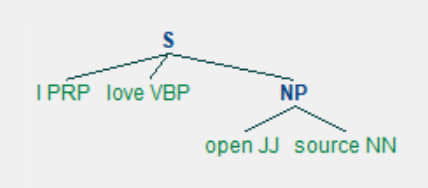进阶教程:用 Python 和 NLTK 进行 NLP 分析
进一步学习自然语言处理的基本概念

在 之前的文章 里,我介绍了 自然语言处理 (NLP)和宾夕法尼亚大学研发的 自然语言处理工具包 (NLTK)。我演示了用 Python 解析文本和定义 停顿词 的方法,并介绍了 语料库 的概念。语料库是由文本构成的数据集,通过提供现成的文本数据来辅助文本处理。在这篇文章里,我将继续用各种语料库对文本进行对比和分析。
这篇文章主要包括以下部分:
- 词网 和 同义词集
- 相似度比较
- 树 和 树库
- 命名实体识别
词网和同义词集
词网 是 NLTK 里的一个大型词汇数据库语料库。词网包含各单词的诸多 认知同义词 (认知同义词常被称作“ 同义词集 ”)。在词网里,名词、动词、形容词和副词,各自被组织成一个同义词的网络。
词网是一个很有用的文本分析工具。它有面向多种语言的版本(汉语、英语、日语、俄语和西班牙语等),也使用多种许可证(从开源许可证到商业许可证都有)。初代版本的词网由普林斯顿大学研发,面向英语,使用 类 MIT 许可证 。
因为一个词可能有多个意义或多个词性,所以可能与多个同义词集相关联。每个同义词集通常提供下列属性:
| 属性 | 定义 | 例子 |
|---|---|---|
| 名称 | 此同义词集的名称 | 单词 code 有 5 个同义词集,名称分别是 code.n.01、 code.n.02、 code.n.03、code.v.01 和 code.v.02 |
| 词性 | 此同义词集的词性 | 单词 code 有 3 个名词词性的同义词集和 2 个动词词性的同义词集 |
| 定义 | 该词作对应词性时的定义 | 动词 code 的一个定义是:(计算机科学)数据或计算机程序指令的 象征性排列 |
| 例子 | 使用该词的例子 | code 一词的例子:We should encode the message for security reasons |
| 词元 | 与该词相关联的其他同义词集(包括那些不一定严格地是该词的同义词,但可以大体看作同义词的);词元直接与其他词元相关联,而不是直接与 单词 相关联 | code.v.02 的词元是 code.v.02.encipher、code.v.02.cipher、code.v.02.cypher、code.v.02.encrypt、code.v.02.inscribe 和 code.v.02.write_in_code |
| 反义词 | 意思相反的词 | 词元 encode.v.01.encode 的反义词是 decode.v.01.decode |
| 上义词 | 该词所属的一个范畴更大的词 | code.v.01 的一个上义词是 tag.v.01 |
| 分项词 | 属于该词组成部分的词 | computer 的一个分项词是 chip |
| 总项词 | 该词作为组成部分所属的词 | window 的一个总项词是 computer screen |
同义词集还有一些其他属性,在 <你的 Python 安装路径>/Lib/site-packages 下的 nltk/corpus/reader/wordnet.py,你可以找到它们。
下面的代码或许可以帮助理解。
这个函数:
from nltk.corpus import wordnet
def synset_info(synset):
print("Name", synset.name())
print("POS:", synset.pos())
print("Definition:", synset.definition())
print("Examples:", synset.examples())
print("Lemmas:", synset.lemmas())
print("Antonyms:", [lemma.antonyms() for lemma in synset.lemmas() if len(lemma.antonyms()) > 0])
print("Hypernyms:", synset.hypernyms())
print("Instance Hypernyms:", synset.instance_hypernyms())
print("Part Holonyms:", synset.part_holonyms())
print("Part Meronyms:", synset.part_meronyms())
print()
synsets = wordnet.synsets('code')
print(len(synsets), "synsets:")
for synset in synsets:
synset_info(synset)
将会显示:
5 synsets:
Name code.n.01
POS: n
Definition: a set of rules or principles or laws (especially written ones)
Examples: []
Lemmas: [Lemma('code.n.01.code'), Lemma('code.n.01.codification')]
Antonyms: []
Hypernyms: [Synset('written_communication.n.01')]
Instance Hpernyms: []
Part Holonyms: []
Part Meronyms: []
...
Name code.n.03
POS: n
Definition: (computer science) the symbolic arrangement of data or instructions in a computer program or the set of such instructions
Examples: []
Lemmas: [Lemma('code.n.03.code'), Lemma('code.n.03.computer_code')]
Antonyms: []
Hypernyms: [Synset('coding_system.n.01')]
Instance Hpernyms: []
Part Holonyms: []
Part Meronyms: []
...
Name code.v.02
POS: v
Definition: convert ordinary language into code
Examples: ['We should encode the message for security reasons']
Lemmas: [Lemma('code.v.02.code'), Lemma('code.v.02.encipher'), Lemma('code.v.02.cipher'), Lemma('code.v.02.cypher'), Lemma('code.v.02.encrypt'), Lemma('code.v.02.inscribe'), Lemma('code.v.02.write_in_code')]
Antonyms: []
Hypernyms: [Synset('encode.v.01')]
Instance Hpernyms: []
Part Holonyms: []
Part Meronyms: []
同义词集 和 词元 在词网里是按照树状结构组织起来的,下面的代码会给出直观的展现:
def hypernyms(synset):
return synset.hypernyms()
synsets = wordnet.synsets('soccer')
for synset in synsets:
print(synset.name() + " tree:")
pprint(synset.tree(rel=hypernyms))
print()
code.n.01 tree:
[Synset('code.n.01'),
[Synset('written_communication.n.01'),
...
code.n.02 tree:
[Synset('code.n.02'),
[Synset('coding_system.n.01'),
...
code.n.03 tree:
[Synset('code.n.03'),
...
code.v.01 tree:
[Synset('code.v.01'),
[Synset('tag.v.01'),
...
code.v.02 tree:
[Synset('code.v.02'),
[Synset('encode.v.01'),
...
词网并没有涵盖所有的单词和其信息(现今英语有约 17,0000 个单词,最新版的 词网 涵盖了约 15,5000 个),但它开了个好头。掌握了“词网”的各个概念后,如果你觉得它词汇少,不能满足你的需要,可以转而使用其他工具。或者,你也可以打造自己的“词网”!
自主尝试
使用 Python 库,下载维基百科的 “open source” 页面,并列出该页面所有单词的 同义词集 和 词元 。
相似度比较
相似度比较的目的是识别出两篇文本的相似度,在搜索引擎、聊天机器人等方面有很多应用。
比如,相似度比较可以识别 football 和 soccer 是否有相似性。
syn1 = wordnet.synsets('football')
syn2 = wordnet.synsets('soccer')
# 一个单词可能有多个 同义词集,需要把 word1 的每个同义词集和 word2 的每个同义词集分别比较
for s1 in syn1:
for s2 in syn2:
print("Path similarity of: ")
print(s1, '(', s1.pos(), ')', '[', s1.definition(), ']')
print(s2, '(', s2.pos(), ')', '[', s2.definition(), ']')
print(" is", s1.path_similarity(s2))
print()
Path similarity of:
Synset('football.n.01') ( n ) [ any of various games played with a ball (round or oval) in which two teams try to kick or carry or propel the ball into each other's goal ]
Synset('soccer.n.01') ( n ) [ a football game in which two teams of 11 players try to kick or head a ball into the opponents' goal ]
is 0.5
Path similarity of:
Synset('football.n.02') ( n ) [ the inflated oblong ball used in playing American football ]
Synset('soccer.n.01') ( n ) [ a football game in which two teams of 11 players try to kick or head a ball into the opponents' goal ]
is 0.05
两个词各个同义词集之间 路径相似度 最大的是 0.5,表明它们关联性很大( 路径相似度 指两个词的意义在 上下义关系的词汇分类结构 中的最短距离)。
那么 code 和 bug 呢?这两个计算机领域的词的相似度是:
Path similarity of:
Synset('code.n.01') ( n ) [ a set of rules or principles or laws (especially written ones) ]
Synset('bug.n.02') ( n ) [ a fault or defect in a computer program, system, or machine ]
is 0.1111111111111111
...
Path similarity of:
Synset('code.n.02') ( n ) [ a coding system used for transmitting messages requiring brevity or secrecy ]
Synset('bug.n.02') ( n ) [ a fault or defect in a computer program, system, or machine ]
is 0.09090909090909091
...
Path similarity of:
Synset('code.n.03') ( n ) [ (computer science) the symbolic arrangement of data or instructions in a computer program or the set of such instructions ]
Synset('bug.n.02') ( n ) [ a fault or defect in a computer program, system, or machine ]
is 0.09090909090909091
这些是这两个词各同义词集之间 路径相似度 的最大值,这些值表明两个词是有关联性的。
NLTK 提供多种 相似度计分器 ,比如:
- path_similarity
- lch_similarity
- wup_similarity
- res_similarity
- jcn_similarity
- lin_similarity
要进一步了解这些 相似度计分器 ,请查看 WordNet Interface 的 Similarity 部分。
自主尝试
使用 Python 库,从维基百科的 Category: Lists of computer terms 生成一个术语列表,然后计算各术语之间的相似度。
树和树库
使用 NLTK,你可以把文本表示成树状结构以便进行分析。
这里有一个例子:
这是一份简短的文本,对其做预处理和词性标注:
import nltk
text = "I love open source"
# Tokenize to words
words = nltk.tokenize.word_tokenize(text)
# POS tag the words
words_tagged = nltk.pos_tag(words)
要把文本转换成树状结构,你必须定义一个 语法 。这个例子里用的是一个基于 Penn Treebank tags 的简单语法。
# A simple grammar to create tree
grammar = "NP: {<JJ><NN>}"
然后用这个 语法 创建一颗 树 :
# Create tree
parser = nltk.RegexpParser(grammar)
tree = parser.parse(words_tagged)
pprint(tree)
运行上面的代码,将得到:
Tree('S', [('I', 'PRP'), ('love', 'VBP'), Tree('NP', [('open', 'JJ'), ('source', 'NN')])])
你也可以图形化地显示结果。
tree.draw()

这个树状结构有助于准确解读文本的意思。比如,用它可以找到文本的 主语:
subject_tags = ["NN", "NNS", "NP", "NNP", "NNPS", "PRP", "PRP$"]
def subject(sentence_tree):
for tagged_word in sentence_tree:
# A crude logic for this case - first word with these tags is considered subject
if tagged_word[1] in subject_tags:
return tagged_word[0]
print("Subject:", subject(tree))
结果显示主语是 I:
Subject: I
这是一个比较基础的文本分析步骤,可以用到更广泛的应用场景中。 比如,在聊天机器人方面,如果用户告诉机器人:“给我妈妈 Jane 预订一张机票,1 月 1 号伦敦飞纽约的”,机器人可以用这种分析方法解读这个指令:
动作: 预订
动作的对象: 机票
乘客: Jane
出发地: 伦敦
目的地: 纽约
日期: (明年)1 月 1 号
树库 指由许多预先标注好的 树 构成的语料库。现在已经有面向多种语言的树库,既有开源的,也有限定条件下才能免费使用的,以及商用的。其中使用最广泛的是面向英语的宾州树库。宾州树库取材于 华尔街日报 。NLTK 也包含了宾州树库作为一个子语料库。下面是一些使用 树库 的方法:
words = nltk.corpus.treebank.words()
print(len(words), "words:")
print(words)
tagged_sents = nltk.corpus.treebank.tagged_sents()
print(len(tagged_sents), "sentences:")
print(tagged_sents)
100676 words:
['Pierre', 'Vinken', ',', '61', 'years', 'old', ',', ...]
3914 sentences:
[[('Pierre', 'NNP'), ('Vinken', 'NNP'), (',', ','), ('61', 'CD'), ('years', 'NNS'), ('old', 'JJ'), (',', ','), ('will', 'MD'), ('join', 'VB'), ('the', 'DT'), ('board', 'NN'), ('as', 'IN'), ('a', 'DT'), ('nonexecutive', 'JJ'), ('director', 'NN'), ...]
查看一个句子里的各个 标签 :
sent0 = tagged_sents[0]
pprint(sent0)
[('Pierre', 'NNP'),
('Vinken', 'NNP'),
(',', ','),
('61', 'CD'),
('years', 'NNS'),
...
定义一个 语法 来把这个句子转换成树状结构:
grammar = '''
Subject: {<NNP><NNP>}
SubjectInfo: {<CD><NNS><JJ>}
Action: {<MD><VB>}
Object: {<DT><NN>}
Stopwords: {<IN><DT>}
ObjectInfo: {<JJ><NN>}
When: {<NNP><CD>}
'''
parser = nltk.RegexpParser(grammar)
tree = parser.parse(sent0)
print(tree)
(S
(Subject Pierre/NNP Vinken/NNP)
,/,
(SubjectInfo 61/CD years/NNS old/JJ)
,/,
(Action will/MD join/VB)
(Object the/DT board/NN)
as/IN
a/DT
(ObjectInfo nonexecutive/JJ director/NN)
(Subject Nov./NNP)
29/CD
./.)
图形化地显示:
tree.draw()

树 和 树库 的概念是文本分析的一个强大的组成部分。
自主尝试
使用 Python 库,下载维基百科的 “open source” 页面,将得到的文本以图形化的树状结构展现出来。
命名实体识别
无论口语还是书面语都包含着重要数据。文本处理的主要目标之一,就是提取出关键数据。几乎所有应用场景所需要提取关键数据,比如航空公司的订票机器人或者问答机器人。 NLTK 为此提供了一个 命名实体识别 的功能。
这里有一个代码示例:
sentence = 'Peterson first suggested the name "open source" at Palo Alto, California'
验证这个句子里的 人名 和 地名 有没有被识别出来。照例先预处理:
import nltk
words = nltk.word_tokenize(sentence)
pos_tagged = nltk.pos_tag(words)
运行 命名实体标注器 :
ne_tagged = nltk.ne_chunk(pos_tagged)
print("NE tagged text:")
print(ne_tagged)
print()
NE tagged text:
(S
(PERSON Peterson/NNP)
first/RB
suggested/VBD
the/DT
name/NN
``/``
open/JJ
source/NN
''/''
at/IN
(FACILITY Palo/NNP Alto/NNP)
,/,
(GPE California/NNP))
上面的结果里,命名实体被识别出来并做了标注;只提取这个 树 里的命名实体:
print("Recognized named entities:")
for ne in ne_tagged:
if hasattr(ne, "label"):
print(ne.label(), ne[0:])
Recognized named entities:
PERSON [('Peterson', 'NNP')]
FACILITY [('Palo', 'NNP'), ('Alto', 'NNP')]
GPE [('California', 'NNP')]
图形化地显示:
ne_tagged.draw()

NLTK 内置的 命名实体标注器 ,使用的是宾州法尼亚大学的 Automatic Content Extraction(ACE)程序。该标注器能够识别 组织机构 、人名 、地名 、设施 和 地缘政治实体 等常见 实体 。
NLTK 也可以使用其他 标注器 ,比如 Stanford Named Entity Recognizer. 这个经过训练的标注器用 Java 写成,但 NLTK 提供了一个使用它的接口(详情请查看 nltk.parse.stanford 或 nltk.tag.stanford)。
自主尝试
使用 Python 库,下载维基百科的 “open source” 页面,并识别出对 开源 有影响力的人的名字,以及他们为 开源 做贡献的时间和地点。
高级实践
如果你准备好了,尝试用这篇文章以及此前的文章介绍的知识构建一个 超级结构 。
使用 Python 库,下载维基百科的 “Category: Computer science page”,然后:
- 找出其中频率最高的 单词 、二元搭配 和 三元搭配 ,将它们作为一个关键词列表或者技术列表。相关领域的学生或者工程师需要了解这样一份列表里的内容。
- 图形化地显示这个领域里重要的人名、技术、日期和地点。这会是一份很棒的信息图。
- 构建一个搜索引擎。你的搜索引擎性能能够超过维基百科吗?
下一步?
自然语言处理是 应用构建 的典型支柱。NLTK 是经典、丰富且强大的工具集,提供了为现实世界构建有吸引力、目标明确的应用的工作坊。
在这个系列的文章里,我用 NLTK 作为例子,展示了自然语言处理可以做什么。自然语言处理和 NLTK 还有太多东西值得探索,这个系列的文章只是帮助你探索它们的切入点。
如果你的需求增长到 NLTK 已经满足不了了,你可以训练新的模型或者向 NLTK 添加新的功能。基于 NLTK 构建的新的自然语言处理库正在不断涌现,机器学习也正被深度用于自然语言处理。
via: https://opensource.com/article/20/8/nlp-python-nltk
作者:Girish Managoli 选题:lujun9972 译者:tanloong 校对:wxy